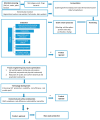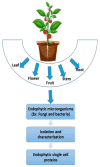Cellular Solutions: Evaluating Single-Cell Proteins as Sustainable Feed Alternatives in Aquaculture
- PMID: 40723325
- PMCID: PMC12292964
- DOI: 10.3390/biology14070764
Cellular Solutions: Evaluating Single-Cell Proteins as Sustainable Feed Alternatives in Aquaculture
Abstract
The rapid expansion of the global population has intensified the demand for protein-rich food sources, positioning aquaculture as a crucial sector in the endeavor to alleviate global hunger through the provision of high-quality aquatic protein. Traditional protein sources such as fishmeal have historically served as the foundation of aquafeeds; however, their elevated costs and limited availability have catalyzed the search for sustainable alternatives. These alternatives encompass plant-based proteins, insect meals, and, more recently, single-cell proteins (SCPs), which are derived from microorganisms including bacteria, yeast, fungi, and microalgae. Nonetheless, SCP remains in its nascent stages and currently accounts for only a minor fraction of aquafeed formulations relative to other established alternatives. The production of SCP utilizes low-cost substrates, such as agricultural and dairy wastes, thereby supporting waste mitigation and principles of the circular economy. This review elucidates the nutritional value of SCPs, their potential for biofortification, and their emerging roles as functional feeds with immunomodulatory and nutrigenomic effects. Additionally, the review underscores the potential of endophytes as a novel SCP source, highlighting their underutilized capacity to foster sustainable innovations in aquafeeds.
Keywords: alternative protein; biofortification; circular economy; nutrigenomics; single-cell protein.
Conflict of interest statement
The authors declare no conflicts of interest.
Figures






Similar articles
-
Management of urinary stones by experts in stone disease (ESD 2025).Arch Ital Urol Androl. 2025 Jun 30;97(2):14085. doi: 10.4081/aiua.2025.14085. Epub 2025 Jun 30. Arch Ital Urol Androl. 2025. PMID: 40583613 Review.
-
Short-Term Memory Impairment.2024 Jun 8. In: StatPearls [Internet]. Treasure Island (FL): StatPearls Publishing; 2025 Jan–. 2024 Jun 8. In: StatPearls [Internet]. Treasure Island (FL): StatPearls Publishing; 2025 Jan–. PMID: 31424720 Free Books & Documents.
-
Ruminant nutrition symposium: novel microbial solutions to optimize production efficiency in beef and dairy systems.J Anim Sci. 2025 Jan 4;103:skaf165. doi: 10.1093/jas/skaf165. J Anim Sci. 2025. PMID: 40372016 Free PMC article. Review.
-
Wood Waste Valorization and Classification Approaches: A systematic review.Open Res Eur. 2025 May 6;5:5. doi: 10.12688/openreseurope.18862.2. eCollection 2025. Open Res Eur. 2025. PMID: 40438563 Free PMC article.
-
A rapid and systematic review of the clinical effectiveness and cost-effectiveness of paclitaxel, docetaxel, gemcitabine and vinorelbine in non-small-cell lung cancer.Health Technol Assess. 2001;5(32):1-195. doi: 10.3310/hta5320. Health Technol Assess. 2001. PMID: 12065068
References
-
- Miladinov G. Impacts of Population Growth and Economic Development on Food Security in Low-Income and Middle-Income Countries. Front. Hum. Dyn. 2023;5:1121662. doi: 10.3389/fhumd.2023.1121662. - DOI
-
- FAO . The State of World Fisheries and Aquaculture 2024—Blue Transformation in Action. FAO; Rome, Italy: 2024. - DOI
-
- FAO. IFAD. UNICEF. WFP. WHO . The State of Food Security and Nutrition in the World 2024—Financing to End Hunger, Food Insecurity and Malnutrition in All Its Forms. FAO; Rome, Italy: 2024. - DOI
-
- Torres-Maravilla E., Parra M., Maisey K., Vargas R.A., Cabezas-Cruz A., Gonzalez A., Tello M., Bermúdez-Humarán L.G. Importance of Probiotics in Fish Aquaculture: Towards the Identification and Design of Novel Probiotics. Microorganisms. 2024;12:626. doi: 10.3390/microorganisms12030626. - DOI - PMC - PubMed
Publication types
LinkOut - more resources
Full Text Sources

